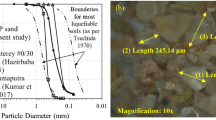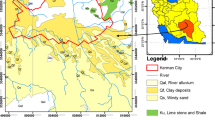Abstract
Properly estimating strain-dependent shear stiffness of soils is necessary for accurate analysis of soil-structure interaction and seismic ground response problems during earthquake motions. In this research, an artificial neural network (ANN) model was developed for shear stiffness ratio of cohesionless soils. The input variables in this model are shear strain amplitude (γ), effective confining pressure (σ′ 0 ), mean grain size (D 50 ), and relative density (D r ) and output is shear stiffness ratio (G/G max ). A large experimental database was compiled from available published laboratory cyclic tests. Validation of model was carried out with using centrifuge tests results. Subsequently, sensitivity analysis and model accuracy was conducted. Finally, proposed model has been compared with other researcher’s relationships. The results clearly demonstrate the good performance and capability of the proposed ANN-based model.











Similar content being viewed by others
Abbreviations
- ANN:
-
Artificial neural network
- G:
-
Shear stiffness
- Gmax :
-
Shear stiffness at small strains
- G/Gmax :
-
Shear stiffness ratio
- D50 :
-
Mean grain size
- Dr :
-
Relative density
- σ′0 :
-
Effective confining pressure
- γ:
-
Shear strain amplitude
- e:
-
Void ratio
- R2 :
-
Coefficient of determination
- MAE:
-
Mean absolute error
- RMSE:
-
Root mean squared error
- Min.:
-
Minimum
- Max.:
-
Maximum
- S.D.:
-
Standard deviation
- N:
-
Number of data
- Xm :
-
Measured value
- Xp :
-
Predicted value
References
Aghaei Araei A, Razeghi HR, Hashemi Tabatabaei S, Ghalandarzadeh A (2010) Dynamic properties of gravelly materials. Sci Iran Trans A Civ Eng 17(4):245–261
Alexhander I, Morton H (1993) Neurons and symbols: the staff that mind is made of. Chapman and Hall, London
Anderson JA (1995) An introduction to neural networks. A bradford book. MIT, Cambridge
Arbib MA (1995) Handbook of brain theory and NN. MIT, Cambridge
Baziar MH, Jafarian Y (2007) Assessment of liquefaction triggering using strain energy concept and ANN model: capacity energy. Soil Dyn Earthq Eng 27:1056–1072
Brennan AJ, Thusyanthan NI, Madabhushi SPG (2005) Evaluation of shear modulus and damping in dynamic centrifuge tests. J Geotech Geoenviron Eng 131(12):1488–1497
Dammala PK, Krishna AM, Bhattacharya S, Nikitas G, Rouholamin M (2017) Dynamic soil properties for seismic ground response studies in Northeastern India. Soil Dyn Earthq Eng 100:357–370
Darendeli MB (2001) Development of a new family of normalized modulus reduction and material damping curves. PhD dissertation, University of Texas at Austin, Austin, Texas
Dehghani AA, Bahremand AR, Shojaei S (2017) Intelligent estimation of flood hydrographs using an adaptive neuro-fuzzy inference system (ANFIS). Model Earth Syst Environ 3(1):35
Ellis GW, Yao C, Zhao R, Penumado D (1995) Stress–Strain modeling of sands using artificial neural networks. J of Geotech Geoenviron Eng 121(5):429–435
Fashi FH (2016) Evaluation of adaptive neural-based fuzzy inference system approach for estimating saturated soil water content. Model Earth Syst Environ 2(4):197
Fausett LV (1994) Fundamentals neural networks: architecture, algorithms, and applications. Prentice-Hall, Englewood Cliffs
Galushkin AI (2007) Neural networks theory. Springer, New York
Gholami M, Bodaghi A (2017) A robust approach through combining optimized neural network and optimized support vector regression for modeling deformation modulus of rock masses. Model Earth Syst Environ 3(1):22
Goto S, Suzuki Y, Nishio S, Oh-oka H (1992) Mechanical properties of undisturbed tone-river gravel obtained by in-situ freezing method. Soils Found 32(3):15–25
Hardin BO, Drnevich VP (1972) Shear modulus and damping in soils; measurement and parameter effects. J Soil Mech Found Div 98(SM6):603–624
Hardin BO, Kalinski ME (2005) Estimating the shear modulus of gravelly soils. J Geotech Geoenviron Eng 131(7):867–875
Haykin S (1994) Neural networks. Macmillan College Publishing Company Inc, New York
Ishibashi I, Zhang X (1993) Unified dynamic shear moduli and damping ratios of sand and clay. Soils Found 33(1):182–191
Iwasaki T, Tatsuoka F (1977) Effects of grain size and grading on dynamic shear moduli of sands. Soils Found 17(3):19–35
Iwasaki T, Tatsuoka F, Takagi Y (1978) Shear moduli of sands under cyclic torsional shear loading. Soils Found 18(1):39–56
Jafarian Y, Kermani E, Baziar MH (2010) Empirical predictive model for the vmax/amax ratio of strong ground motions using genetic programming. Comput and Geosci 36(12):1523–1531
Jafarian Y, Haddad A, Javdanian H (2014) Predictive model for normalized shear modulus of cohesive soils. Acta Geodyn Geomater 11(1):89–100
Jafarian Y, Haddad A, Javdanian H (2015) Comparing the shear stiffness of calcareous and silicate sands under dynamic and cyclic straining. In: 7th International Conference of Seismology and Earthquake Engineering (SEE7), 18 May, Tehran, Iran
Jafarian Y, Haddad A, Javdanian H (2016a) Estimating the shearing modulus of Boushehr calcareous sand using resonant column and cyclic triaxial experiments. Modares Civ Eng J 15(4):9–19 (in Persian)
Jafarian Y, Javdanian H, Haddad A (2016b) Comparing dynamic behavior of Hormuz calcareous and Babolsar siliceous sands under identical conditions. Bull Earthq Sci Eng 3(3):1–10 (in Persian)
Javadi AA, Rezania M, Mousavi Nezhad M (2006) Evaluation of liquefaction induced lateral displacements using genetic programming. Comput Geotech 33:222–233
Javan K, Lialestani MRFH, Ashouri H., Moosavian N (2015) Assessment of the impacts of nonstationarity on watershed runoff using artificial neural networks: a case study in Ardebil, Iran. Model Earth Syst Environ 1(3):22
Javdanian H, Seidali M (2016) Evaluating liquefaction induced lateral spreading. In: 5th International Conference on Geotechnical Engineering and Soil Mechanics, 15 November, Tehran, Iran
Javdanian H, Haddad A, Mehrzad B (2012) Experimental and numerical investigation of the bearing capacity of adjacent footings on reinforced soil. Electron J Geotech Eng 17(R):2597–2617
Javdanian H, Haddad A, Jafarian A (2015a) Evaluation of dynamic behavior of fine-grained soils using group method of data handling. Transp Infrastruct Eng 1(3):77–92. doi:10.22075/jtie.2015.318
Javdanian H, Jafarian Y, Haddad A (2015b) Predicting damping ratio of fine-grained soils using soft computing methodology. Arab J Geosci 8(6):3959–3969
Javdanian H, Heidari A, Kamgar R (2017) Energy-based estimation of soil liquefaction potential using GMDH algorithm. Iran J Sci Technol Trans Civ Eng. doi:10.1007/s40996-017-0061-4
Keshavarzi A, Omran ESE, Bateni SM, Pradhan B, Vasu D, Bagherzadeh A (2016) Modeling of available soil phosphorus (ASP) using multi-objective group method of data handling. Model Earth Syst Environ 2(3):157
Kokusho T (1980) Cyclic triaxial test of dynamic soil properties for wide strain range. Soils Found 20(2):45–60
Levenberg K (1944) A method for the solution of certain non-linear problems in least Squares. Q Appl Math 2(2):164–168
Marquardt DW (1963) An algorithm for least-squares estimation of nonlinear parameters. J Soc Ind Appl Math 11(2):431–441
Masters T (1993) Practical neural network recipes in C++. Academic, San Diego
McCombie P, Wilkinson P (2002) The use of the simple genetic algorithm in finding the critical factor of safety in slope stability analysis. Comput Geotech 29:699–714
Nimtaj A, Javdanian H (2014) Response analysis of layered soil in frequency domain using dynamic matrix. Geodyn Res Int Bull GRIB 2(2):20–33
Parsaie A, Najafian S, Shamsi Z (2016) Predictive modeling of discharge of flow in compound open channel using radial basis neural network. Model Earth Syst Environ 2(3):150
Ribay ED, Maigre ID, Cabrillac R, Gouvenot D (2004) Shear modulus and damping ratio of grouted sand. Soil Dyn Earthq Eng 24:461–471
Roblee C, Chiou B (2004) A proposed geoindex model for design selection of non-linear properties for site response analysis. In: Proc., NSF/PEER Int. Workshop on Uncertainties in Nonlinear Soil Properties and their Impact on Modeling Dynamic Soil Response, University of California at Berkeley, Berkeley, California
Rollins KM, Evans MD, Diehl NB, Daily WD (1998) Shear modulus and damping relationships for gravels. J Geotech Geoenviron Eng 124(5):396–405
Saxena SK, Reddy KR (1989) Dynamic moduli and damping ratios for monterey No.0 sand by resonant column tests. Soils Found 29(2):37–51
Seed HB, Idriss IM (1970) Soil moduli and damping factors for dynamic response analysis. Earthquake Engineering Research Center, EERC, University of California, Berkeley, Report No. 70-10
Seed HB, Wong RT, Idriss IM, Tokimatsu K (1986) Moduli and damping factors for dynamic analyses of cohesionless soils. J Geotech Eng 112(11):1016–1032
Senetakis K, Anastasiadis A, Pitilakis K, Souli A (2011) Dynamic behavior of sand/rubber mixtures, Part II: effect of rubber content on G/G0-γ-DT curves and volumetric threshold strain. J ASTM Int 9(2):1–12
Senetakis K, Anastasiadis A, Pitilakis K (2012) Dynamic properties of dry sand/rubber (SRM) and gravel/rubber (GRM) mixtures in a wide range of shearing strain amplitude. Soil Dyn Earthq Eng 33:38–53
Shahin MA, Maier HR, Jaksa MB (2002) Predicting settlement of shallow foundations using neural networks. J Geotech Geoenviron Eng 128(9):785–793
Smith M (1993) Neural networks for statistical modeling. Van Nostrand Reinhold, New York
Stokoe KH II, Hwang SK, Lee NJ, Andrus RD (1994) Effects of various parameters on the stiffness and damping of soils at small to medium strains. In: Proc. Int. Symp. prefailure deformation characteristics of geomaterials, Sapporo, vol 2, Japan, pp 785–816
Tatsuoka F, Iwasaki T, Takagi Y (1978) Hysteretic damping of sands under cyclic loading and its relation to shear modulus. Soils Found 18(2):25–40
Wagh VM, Panaskar DB, Muley AA (2017) Estimation of nitrate concentration in groundwater of Kadava river basin-Nashik district, Maharashtra, India by using artificial neural network model. Model Earth Syst Environ 3(1):36
Wasserman PD (1989) Neural computing theory and practice. Prentice Hall Company, Van Nostrand Reinhold, New York
Xenaki VC, Athanasopoulos GA (2008) Dynamic properties and liquefaction resistance of two soil materials in an earthfill dam—laboratory test results. Soil Dyn Earthq Eng 28:605–620
Yasuda N, Matsumoto N (1993) Dynamic deformation characteristics of sand and rockfill materials. Can Geotech J 30:747–757
Zayani R, Bouallegue R, Roviras D (2008) Levenberg-Marquardt learning neural network for adaptive predistortion for time-varying HPA with memory in OFDM systems. In: 16th European Signal Processing Conference, EUSIPCO, Lausanne, Switzerland
Acknowledgements
This work has been financially supported by the research deputy of Shahrekord University. The Grant Number was 95GRN1M39422.
Author information
Authors and Affiliations
Corresponding author
Rights and permissions
About this article
Cite this article
Javdanian, H. Assessment of shear stiffness ratio of cohesionless soils using neural modeling. Model. Earth Syst. Environ. 3, 1045–1053 (2017). https://doi.org/10.1007/s40808-017-0351-7
Received:
Accepted:
Published:
Issue Date:
DOI: https://doi.org/10.1007/s40808-017-0351-7




